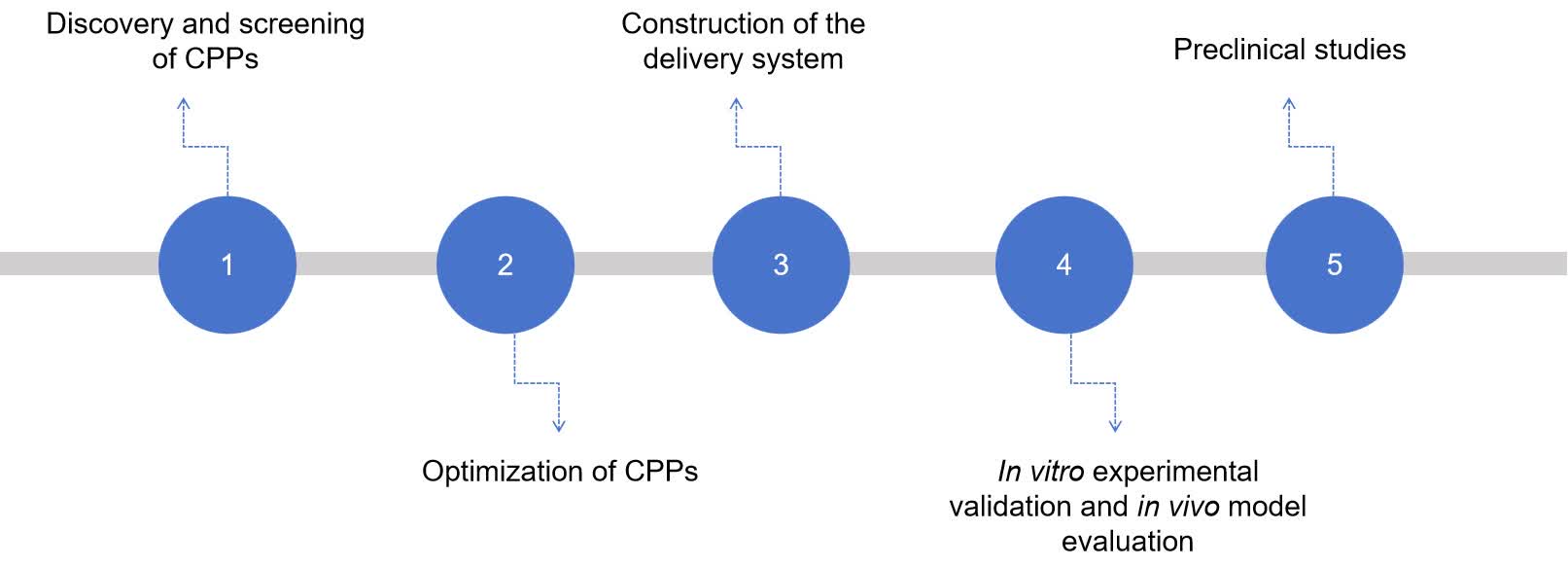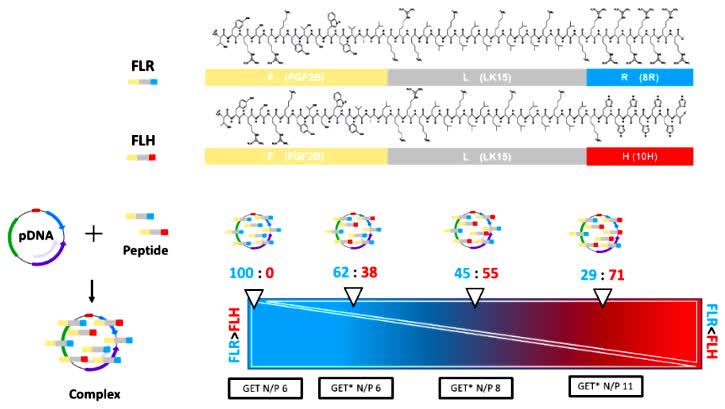Cell-Penetrating Peptide Delivery System Development
Inquiry
Cell-penetrating peptides (CPPs) are a series of oligopeptides composed primarily of hydrophobic and positively charged side chains that increase interaction with cell membranes. CPP-based delivery platforms show great potential for efficient and direct delivery of cytoplasmic solutes including genes.
CD Formulation provides cell-penetrating peptide delivery system development services to improve gene delivery efficiency, delivery targeting, and safety. This technical support plays an important role in the development of non-viral delivery systems for gene therapy.
Advantages of Cell-Penetrating Peptide Delivery System
Cell-penetrating peptides (CPPs) are a class of short peptides that can penetrate cell membranes and deliver various bioactive molecules (e.g., proteins, nucleic acids, drugs, etc.) into cells. In gene therapy, CPPs, as non-viral vectors, have the following characteristics.
- Efficient intracellular delivery. CPPs can efficiently deliver nucleic acid molecules such as therapeutic genes or siRNAs into target cells for gene silencing or functional expression.
- Low immunogenicity. CPPs are generally less immunogenic than viral vectors, reducing the potential for an immune response during treatment.
- Tissue specificity. Through structural modification or conjugation with other molecules, CPPs can be engineered to have specific tissue or cell type targeting, improving therapeutic precision.
- Multifunctionality. CPPs can not only be used as gene carriers but can also be combined with other therapeutic molecules, such as drugs and proteins, to realize multifunctional combination therapy.
Our Services for Developing Cell-Penetrating Peptide Delivery System
Discovery and screening of CPPs
CPPs are a class of small-molecule polypeptides that can penetrate cell membranes. We screened different peptide sequences according to our research objectives to find CPPs that can effectively penetrate cell membranes and carry drug molecules into the cell interior.
Optimization of CPPs
We need to further improve the penetration efficiency and reduce the potential toxicity of CPPs through structural modification and sequence optimization. For example, we have continuously optimized CPPs and were able to effectively improve the escape efficiency and serum tolerance of endocytosed vesicles by introducing endocytosed vesicle-specific protease cleavage sites and multimerization structural domains.
Construction of the delivery system
Subsequently, we need to construct complexes of CPPs with drug molecules, which may involve covalent linkages or non-covalent interactions. For example, by introducing pH-sensitive chemical bonds or enzyme-sensitive linkages in CPPs for controlled intracellular release of drugs.
In vitro experimental validation and in vivo model evaluation
We tested the effectiveness of the CPPs delivery system in an in vitro cell culture model, including the cellular uptake rate, subcellular localization, and biological activity of the drug. In addition, we further evaluate the efficacy and safety of the delivery systems by studying the distribution, metabolism, and potential toxicity of the drugs in vivo in animal models.
Preclinical studies
We can help researchers conduct more in-depth pharmacodynamic and toxicological studies in animal models to provide data to support clinical trials.
 Fig.1 Our development process of cell-penetrating peptides. (CD Formulation)
Fig.1 Our development process of cell-penetrating peptides. (CD Formulation)
Optimizing Cell-Penetrating Peptides Delivery Systems for Gene Therapy
- Tumor therapy. CPPs can carry anti-tumor drugs or gene therapy molecules, such as chemotherapeutic agents, siRNAs, or the CRISPR-Cas9 system, specifically into the tumor cells to improve therapeutic efficacy and reduce damage to normal cells.
- Central nervous system diseases. Many drugs have difficulty entering the brain due to the blood-brain barrier, and CPPs can penetrate the blood-brain barrier, thus showing potential for use in the treatment of CNS diseases such as Alzheimer's disease and Parkinson's disease.
- Hereditary diseases. For certain genetic disorders, such as Duchenne muscular dystrophy (DMD), CPPs can carry therapeutic proteins or siRNAs to ameliorate or correct genetic defects.
- Inflammatory diseases. CPPs can be used to carry anti-inflammatory drugs to treat inflammatory diseases such as rheumatoid arthritis by penetrating cell membranes and acting directly on inflammatory cells.
- Otology and ophthalmology diseases. In otology and ophthalmology, CPPs can be used to carry therapeutic molecules that penetrate hard-to-reach tissues, such as the inner ear or retina, to treat sensorineural deafness or certain fundus disorders.
Our Platforms for Cell-Penetrating Peptides Delivery Systems Development
| Technologies & Platforms |
Content Description |
| Chimeric peptide technology platform |
This is a novel chimeric peptide biomolecule entry delivery system that improves the endocytosed vesicle escape efficiency and serum tolerance of CPPs by introducing endocytosed vesicle-specific protease cleavage sites and multimerization structural domains. |
| pH-sensitive peptide technology |
This technology platform utilizes the acidic deformation of pH-sensitive peptides to disrupt endocytosed vesicle membranes and enhance the endocytosed vesicle escape efficiency of CPPs. |
| Chemical modification technology platform |
We develop novel CPPs with enhanced cell penetration, stability, and selectivity through chemical modifications such as cyclization, unnatural amino acid substitution, and N-methylation. |
Highlights of Our Cell-Penetrating Peptides Delivery Systems Development
- Provide customized cell-penetrating peptide design and synthesis.
- Develop CPPs with specific cell or tissue targeting.
- Provide optimization and testing services for drug carrier systems.
- Perform chemical modification of cell-penetrating peptides to improve stability and reduce immunogenicity.
- Efficient and reliable non-viral delivery system development services and ensure timely delivery of project results.
Published Data
Technology: Peptide synthesis technology platform
Journal: Int J Mol Sci
IF: 5.6
Published: 2022
This study developed a modified peptide (FLH) to improve plasmid DNA (pDNA) delivery, creating GET nanoparticles. These nanoparticles were incorporated into collagen–nanohydroxyapatite scaffolds, which were optimized for osteogenic capacity. The study found that a specific formulation, GET N/P 8, was most effective for delivering pDNA to mesenchymal stem cells (MSCs) in two dimensions. The scaffolds were used to deliver pSDF-1α, a gene encoding for an angiogenic chemokine, to MSCs, leading to increased production of SDF-1α protein and an enhanced angiogenic effect, which is crucial for the early stages of bone repair.
 Fig.2 Cell-penetrating peptide combination. (Power RN, et al., 2022)
Fig.2 Cell-penetrating peptide combination. (Power RN, et al., 2022)
CD Formulation is committed to the field of gene therapy research, and our development of delivery systems for CPPs is of great importance in gene therapy to help researchers make a strong push to advance the development and study of non-viral gene delivery systems. If you are interested in us, please feel free to contact us.
References
- Power RN, et al. Development of a Gene-Activated Scaffold Incorporating Multifunctional Cell-Penetrating Peptides for pSDF-1α Delivery for Enhanced Angiogenesis in Tissue Engineering Applications. Int J Mol Sci. 2022, 23(3):1460.
Related Services

 Fig.1 Our development process of cell-penetrating peptides. (CD Formulation)
Fig.1 Our development process of cell-penetrating peptides. (CD Formulation) Fig.2 Cell-penetrating peptide combination. (Power RN, et al., 2022)
Fig.2 Cell-penetrating peptide combination. (Power RN, et al., 2022)